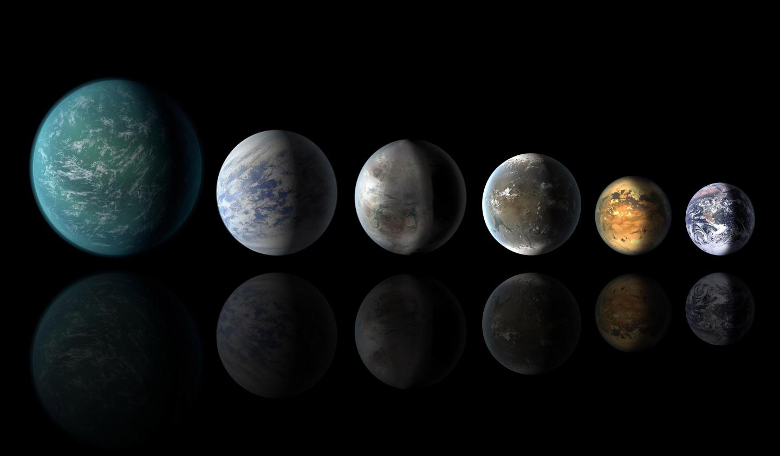A new evaluation of Kepler data on the sizes of exoplanets indicates that planets naturally fall into certain size groups, but more interestingly, those which are between two to four times the radius of Earth are likely to be water worlds; not only that, but this type of planet could be widespread throughout the galaxy (and presumably the Universe).
Pinning down Earth-like worlds has been high on the agenda ever since the first exoplanet found orbiting a sun-like star was discovered in 1995. Since then, a number of missions have set out to find and measure details of the plethora of planets we are now accustomed to finding. Most notable in this task has been Kepler, which has found, along with its extended K2 mission, around 2700 confirmed planets and around the same figure again for candidate exoplanets (I.e potential exoplanets whose status has yet to be confirmed).
Now though, the Gaia satellite has upped the stakes in the mission to find habitable worlds, as it has been able to measure the mass and radius of some of the exoplanets that have already been discovered.
Armed with this new data, scientists have been able to use statistics to model the relative growth rate of exoplanets independently of their size (something known as a log-normal distribution), to find that many of the 4000+ confirmed or candidate exoplanets they studied fall naturally into two size categories: those that have a planetary radius four times that of the Earth and those that have a radius 10 times larger than Earth.
Examples of this can be seen in our own Solar System; Uranus and Neptune for example have a radius around four times that of Earth, whereas Jupiter and Saturn’s radius is 10 times that of Earth.
It is easy to see from the planets in our own solar backyard that this division between the two sizes makes for two different types of planet; Uranus and Neptune for example are large, rocky icy planets, while Jupiter and Saturn on the other hand are predominantly gas giants.
So does that mean all planets around the size of Earth should be rocky and full of water? Well, sort of, say the team whose lead author on the recent research paper is Dr Li Zeng from Harvard University.
From the data, the team found another division between planets that had radius’s between two and four Earth radii: rocky planets that are less than 2 radii and water-rich planets that are greater than 2 radii but less than four radii.
The rocky ones, the team say, would be Earths and super-Earth type planets made up of material similar to our own world, while the other group would be classified as volatile-rich worlds; or to use their more common name, water-worlds. The team suggests that over a quarter of the molecular compounds that make up the water-worlds are molecules such as water (H2O), ammonia (NH3) and methane (CH4), along with a small amount of gas.
"We have looked at how mass relates to radius, and developed a model which might explain the relationship", said Li Zeng. The model indicates that those exoplanets which have a radius of around x1.5 Earth radius tend to be rocky planets, while those with a radius of x2.5 Earth radius are probably water worlds".
"This is water, but not as commonly found here on Earth", added Zeng. "Their surface temperature is expected to be in the 200 to 500 degree Celsius range. Their surface may be shrouded in a water-vapour-dominated atmosphere, with a liquid water layer underneath. Moving deeper, one would expect to find this water transforms into high-pressure ices before we reaching the solid rocky core. The beauty of the model is that it explains just how composition relates to the known facts about these planets.”
According to the statistics about 35 percent of all known exoplanets that are bigger than Earth should be water-rich, that likely formed in similar ways to the giant planet cores of our own neighbours (Jupiter, Saturn, Uranus and Neptune).
Its not all good news for planets between four and 10 Earth radii however, as the data indicates that planets that span this range will be relatively uncommon. The team have therefore named them transitional planets, as they form a bridge between the gas-poor small planets and gas giants.
Putting it all together, as exoplanets can now be defined based on their mass and radius, Zheng and team suggest that exoplanets should now be classified according to the following scheme: rocky planets (that are less than 2 Earth radii), water worlds (between 2 and 4 Earth radii), transitional planets (between 4 and 10 Earth radii), and gas giants (greater than 10 Earth radii).
Scientists will have to wait a while longer to help confirm, or indeed refute these new findings as characterising an exoplanets atmosphere is currently very difficult with current ground-based and space-bourne telescopes. However with the impending launch of the James Webb Space Telescope – the successor to the Hubble space telescope – in 2021, their task will hopefully be made considerably easier.











